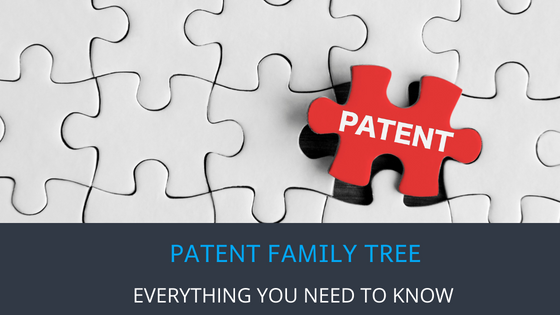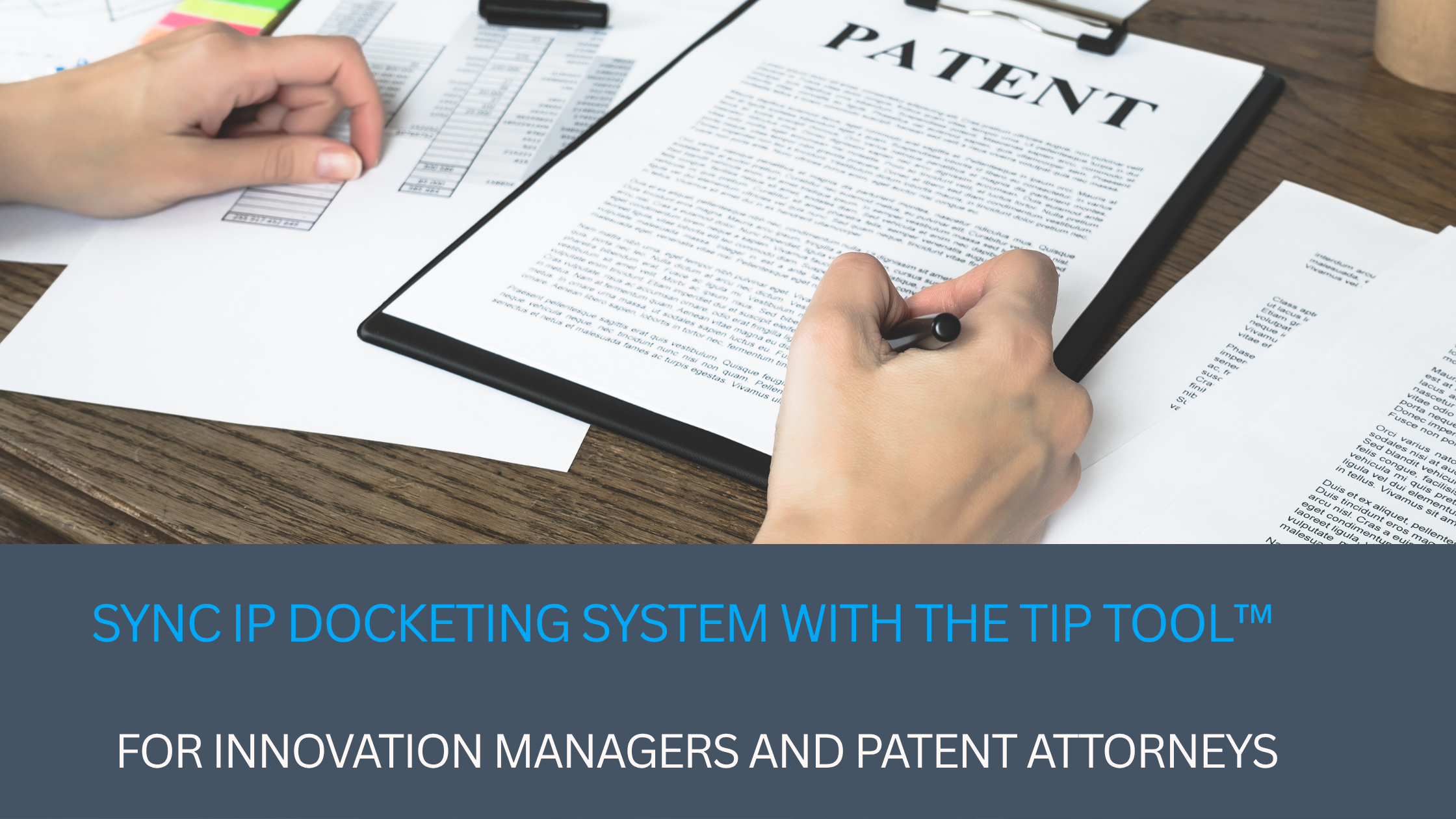A patent family is a group of related patent applications. In most cases, a patent family covers related inventions or features. To take a simple example, an inventor and her patent lawyer might file a patent application for an early version of an invention and a related patent application for an improved version of an invention.
These relationships have legal effects. Child applications receive certain benefits from their parents. Understanding these intricacies is vital for creating an effective global patent portfolio strategy. These benefits tell you the prior art that can be used against the patent family and when the invention’s features act as prior art against others.
Patent practitioners, inventors, IP owners, technology investors, and patent licensees must understand these relationships to make the most of their patent portfolios. One technique to quickly distill this information is through a patent family tree that visually represents the patent family relationships. Through this visualization, you can quickly identify family relationships and gather the information you need from them.
Patent family tree generators are a relatively new tool category. In the past, patent lawyers or paralegals would need to read a patent’s priority claims and manually construct a family tree. This process was time-consuming and prone to errors.
Patent family tree generators from Patentscope, Espacenet, and Triangle IP develop patent family trees automatically. These tools can also create a variety of visualizations so observers can quickly glean patent family information from them.
Patent Families
A patent family is a group of patent applications and patents with interrelating priority claims. A priority claim allows a later-filed application to use the filing date of an earlier-filed application to determine how it relates to prior art references.
To understand the significance of a priority claim, here is an example. Suppose you filed a patent application that claimed Feature A. After filing the patent application, you started marketing your product, including Feature A. You then invent an improvement to the product with Feature A+.
In the U.S., a feature is patentable if it was not known or obvious in view of what was known on the filing date. When Feature A+ is examined, the patent application and product with Feature A could be used as prior art against the application with Feature A+.
A priority claim allows the patent application with Feature A+ to use the filing date of the patent application with Feature A. Now that it has an earlier filing date, neither the patent application nor the product containing Feature A will constitute prior art.
How Do I Determine Which Patents Are Part of the Same Patent Family?
To understand which applications are part of the patent family, you must understand the different types of claims that a patent application can contain. In the U.S., a patent application can claim the priority of an earlier-filed patent application that was still pending as of the filing date of the later-filed application.
Thus, a patent application filed on January 1, 2023, could claim the priority of a patent application filed on July 1, 2022, if the 2022 application was not abandoned or issued on January 1, 2023.
Types of Priority Claims
The priority claims that can create a patent family include the following:
Continuation Applications
A continuation application happens when the applicant decides to file the same application without adding any new matter. These applications often play a significant role in leveraging patents for investment purposes due to their evolving nature. The typical reason for filing a continuation application is to seek additional claim scope.
One example of where this could happen is if the patent issues with a narrow set of claims and the applicant wants to pursue broader claims through a continuation application. Another example of where this could happen is if the patent gets filed (and it’s pending) with a set of claims directed to one aspect or embodiment, and the applicant wants to pursue claims for a different aspect or embodiment.
Continuation-in-Part (CIP) Applications
A continuation-in-part application includes the substance of the parent application but adds new matter. These applications get filed when an applicant wants to pursue claims for an improved version of the invention with new features or modifications of the old features.
Divisional Applications
Patent applications can only claim one invention. When an application claims more than one invention, the examiner can issue a restriction requirement. This restriction requirement forces the applicant to choose one of the inventions for examination in the pending application.
A divisional application includes the exact disclosure of the original application but claims the non-elected invention for examination.
Non-Provisional Applications Based on Provisional Applications
U.S. patent law allows inventors to file provisional applications. A provisional application creates an official record of an invention’s disclosure. Importantly, a provisional receives a priority date for the invention as it was described in the application.
The provisional filing only holds this priority date for one year. To keep that priority date, the applicant must file a non-provisional application claiming the priority of that provisional application. If the applicant fails to file the non-provisional application before the deadline, the priority date gets lost forever.
U.S. National Stage Applications Based on International or Foreign Applications
The U.S. is a member of several international agreements that allow U.S. applications to claim priority to applications filed with non-U.S. patent offices. The most common way to file these applications is with a national-stage application.
A national-stage application contains the same matter as the foreign or international application that serves as its priority document. The national stage application includes an English translation but does not include any new matter.
Patent Family Relationships
You can visualize the members of a patent family by starting with the earliest-filed application. Patent attorneys refer to this application as the parent application.
Divisional applications get the same filing date as the parent application and sit at the same generational level as the parent application. As such, you can think of these applications as twins of the parent application because they were “born” at the same time and contain the same matter.
Continuation applications also have the same filing date as the parent application. Thus, they sit at the same generational level as the parent application. Since they cannot contain any new matter, these are considered twins of the parent application.
National-stage applications also get a U.S. filing date that is the same as the foreign or international application filing date. As a result, these are considered clones of foreign or international applications.
CIP applications that claim priority to that application are child applications. Since they can contain new matter, non-provisional applications that claim the priority of a provisional application can also be thought of as child applications. But most patent lawyers would view these as more of an evolved or grown-up version of the provisional application.
Bear in mind that a patent application can claim the priority of multiple prior applications and patents. Thus, a CIP could have multiple parents. Additionally, you can create families of families. So, an application could be the CIP of a CIP or a divisional of a national-stage application. Thus, you could end up with grandchildren, great-grandchildren, children of siblings, and so forth.
Identifying the Patents in a Patent Family
The priority claims that identify family relationships are usually included in a patent application when it gets filed. For example, the electronic or paper transmittal that accompanies a patent application will usually list any related applications by title, filing date, and application serial number or patent number.
In U.S. patent documents, the body of the application or patent also includes a list of related applications along with the type of relationship. For example, an application might say, “The present application is a continuation-in-part of U.S. Patent Application Serial No. XX/XXX,XXX, titled ‘Patent Title,’ filed on January 15, 2023.”
But there is no guarantee you will be able to find this information when you look for it. Applicants can apply without any priority claims and amend the application during its pendency to include them. Applicants may also decide later to expand the priority claims to include more patents and applications.
Sometimes, this happens out of necessity. For example, if a patent examiner rejects your claims due to one of your earlier filed patents, one option to eliminate that reference as prior art is to claim it as part of the rejected application’s family.
Other times, this may happen when the patent attorney or patent paralegal realizes that a priority claim was inadvertently omitted. When they review the patent family tree, they might realize that the application needs to be amended to add a priority claim.
In either case, the pendency of the subject application must have overlapped with the pendency of the priority document. If the priority document was issued or abandoned on the subject application’s priority date, a priority claim cannot be made.
Using INPADOC to Identify Members of a Patent Family
Rather than combing through the patent transmittals and specifications for priority claims, a database maintained by the European Patent Office (EPO) allied INPADOC can help you identify the members of a patent family. INPADOC uses publicly available information from patent offices around the world to record patent relationships and statuses.
Importantly, this database shows relationships that cross international borders. So, INPADOC would show a parent document filed in Japan, an international application under the Patent Cooperation Treaty filed from the Japanese application, and a subsequent national-stage application in the U.S. Patent Office.
Importantly, INPADOC can only show publicly available information, and it only gets updated once per week. As a result, your results from the database will need to be updated periodically if you plan to monitor an INPADOC patent family.
Patent Family Trees
Patent family trees provide a visual representation of a patent family. Like a genealogical family tree, a patent family tree allows a viewer to quickly identify the relationships between related patents and patent applications.
A good patent family tree will allow you to instantly research the history of a particular patent. It will provide:
- A visual representation of other patents and applications in the family
- Links illustrating the relationships among the patent family members
- Bibliographical information about the patents and applications in the family
You research the history of a particular patent by tracing the links between the subject patent to its predecessors and successors. This can help you identify the earliest patent application to contain the subject matter of the patent you are researching. It will also tell you the earliest priority date claimed.
Intermediate patents in the family can also help your analysis. CIP applications can add new matter or even alter what has been described. Understanding the family line in a family tree of a patent or patent application can help you understand how the language used to describe the invention has evolved.
For example, if the subject patent application claims the feature B2, you can use the patent family tree to identify when B2 first appears, how it differs from B1, and when B1 became B2. Equally importantly, you can trace the family back even further to identify the original feature B and when B1 was first disclosed.
Patent family visualizations can take two forms:
Traditional Patent Family Tree Visualization
In one form, the patent family tree looks like a genealogical family tree. Each box in the family tree represents a separate patent or patent application. The boxes are placed on a horizontal time scale that shows each application’s filing date.
The earliest-filed family members, usually the parents, sit at the top of the tree. The children sit below those applications with lines showing familial relationships. So, in the example family tree below, the subject application (shown in green) has two parents, two children in the U.S., and two foreign children.
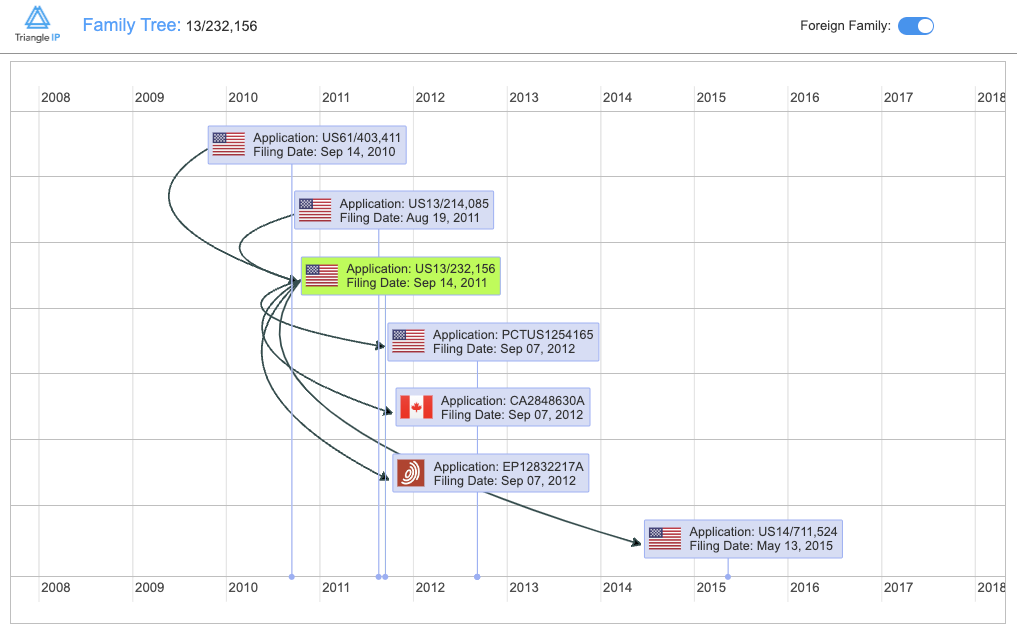
US13/232,156 Patent Family Tree, Generated using The TIP Tool
Gantt Family Tree Visualization
In the Gantt family tree, each patent application is shown as a bar. The horizontal axis represents time. The location and length of the bar for each patent application represent its filing date and expiration date or anticipated expiration date.
A Gantt chart can use different colors to identify different stages in a patent application’s life. For example, a bar can include a green segment for the pendency of the patent application and a blue segment for the term of the issued patent.
This type of visualization allows you to quickly identify the pendency of each application and determine which family members were filed during that time to create a valid priority claim. This type of visualization also quickly illustrates the expiration of each patent in the family.
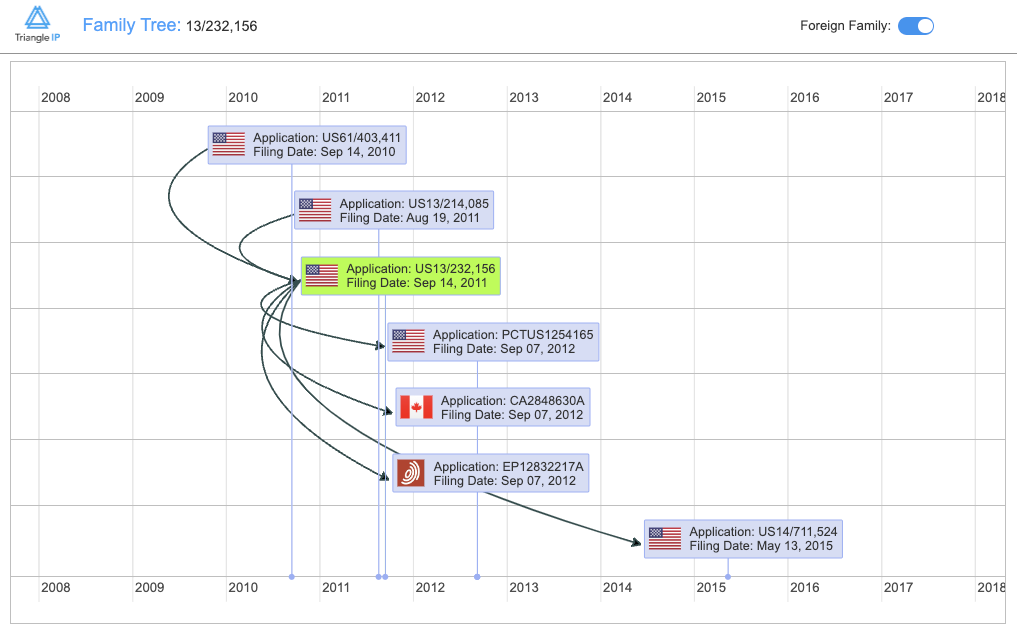
US13/232,156 Patent Family Tree (Gantt Chart Style), Generated using The TIP Tool
Patent Bibliographical Information
Additional information for a patent application in the family tree can be viewed in a popup that appears when the user hovers over or clicks on a bar or box representing a patent or application. The information can give the serial number and filing date. It can even include other useful information like the inventors’ names and patent abstract. The representation of the application could include links to the text of the subject application.
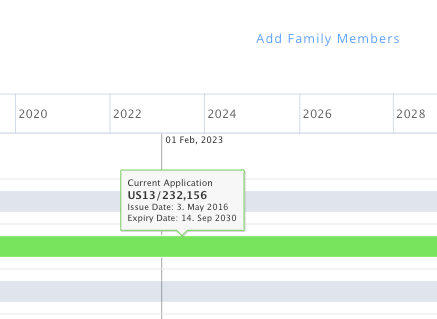
Bibliographical information popup
Using a Patent Family Tree
Patent family trees can help inventors, patent lawyers and paralegals, and corporate counsel to:
Assess the Strength or Value of a Patent Portfolio
The strength and value of a patent portfolio are usually measured by its validity, breadth, interconnectedness, and lifespan. You can assess these characteristics using a patent family tree visualization.
The first characteristic, validity, is largely influenced by the earliest date of the patent family. This date tells you the age of the prior art you must use to try to invalidate the patents and applications in the family. Generally speaking, an earlier date makes a patent portfolio stronger because the universe of potentially invalidating prior art is smaller.
The breadth of a patent portfolio tells you how much subject matter the patent family’s claims cover. While more patent applications do not necessarily make a family broader, the size of the family could suggest broader claim coverage. To take an extreme example, a single patent will probably not have the breadth of a twelve-member patent family.
Interconnectedness requires you to use the patent family tree to identify the members of the family and read their claims to determine each individual application’s scope. This will help you determine what each family member adds to the overall breadth of the family.
Interconnectedness tells you whether the patent owner left gaps between the individual patents. To analogize, a 10-mile wide net has breadth, but it lacks interconnectedness if it has one-mile wide gaps.
Lifetime goes to two factors. First, you need to know how much patent term is left in the patent family. In the U.S., the patent term is measured from the priority date of the earliest priority document. Later-filed patent applications in a family might lose time off its term compared to creating a new family.
Second, you need to know if the family has any pending applications. This allows an acquiring entity to continue to add family members to the patent family. A patent family might have value simply because of what it could become as more applications get added to it.
Identify Potential Competitors or Partners in an Industry
Competitors or partners usually have a few relationships:
- Different solutions to the same problem
- Complementary solutions to a problem
- Same customers or same suppliers
- Supplier/customer relationship
In all of these situations, you want to know the inventions in other companies’ patents. But a patent family can tell you where another company’s future thinking is headed. Patent applications will show you future products, improvements, and modifications other companies have in mind.
A patent family can even tell you how those features have evolved. For example, if you see a whole family covering Feature C, C1, C2, C3, and so forth, you know the other company is probably focused on Feature C and its variants. While every industry is unique, this type of business intelligence can open the door for a competitive advantage over, or a partnership with, the other company.
Identify Potential Licensing Opportunities or Infringing Products
This intelligence can also tell you whether any other companies are coming close to your technology. If you own a patent that claimed Feature D and your competitor’s patent family tree reveals that it is creeping closer and closer to Feature D, you have an opportunity to offer a license to the competitor to use Feature D. Alternatively, you might choose to warn your competitor away from using Feature D or risk infringing.
If you want to move proactively, you might even create your own patent family by filing some applications for variations on Feature D. This will give you a stronger position in both licensing and infringement by cutting off potential alternative designs that get around your patent.
Track and Maintain a Patent Portfolio
You can create a family tree to help you track, manage, and maintain your patent portfolio. Seeing applications represented visually will help you keep all the interrelationships straight in your mind. A patent family tree can also help you identify and plug gaps in your patent portfolio.
Formerly, patent family trees were generated manually. Your patent attorney or paralegal would read each patent or application and enter the priority data into a spreadsheet. You would then use the graphing function of the spreadsheet software to create a family tree. As you filed further patent applications in the family, you would update the spreadsheet so you could update the family tree.
Unfortunately, there was no way to verify a family tree’s accuracy and usefulness except by brute force. You would hire a patent lawyer to review your family tree, which meant paying a few hundred dollars per hour to have someone review and correct your spreadsheet. But there was no way to automatically update or verify your family tree.
This has changed. You have several tools available to you to automatically create family trees and verify them against available patent databases.
Patent Family Tree Generators
Patent family tree generators use patent databases like the U.S. Patent Office’s PAIR and INPADOC to generate a patent family tree. Since they use databases used by the U.S. Patent Office and the European Patent Office (EPO), the family tree will accurately represent the relationships between different patents in a family.
But the publicly available databases lag actual filings since many of the databases only contain published data. This ensures that private data remains private for as long as the applicable jurisdiction’s laws allow. For example, in the U.S. publications occur 18 months after the filing date unless the applicant requests early publication. As a result, the U.S. Patent Office’s Public PAIR database always lacks the most recent 18 months of applications.
Another concern of inventors and patent owners is cost. Some patent docketing software suites can generate patent family trees. But these packages can cost tens of thousands of dollars and require a massive server to process data. And some of these packages only use the docket to generate a patent family tree and do not verify it against the patent office databases.
Three free patent family tree generators overcome both these issues. These tools generate patent family trees for free. And they are cloud-based, so they run entirely online instead of on a server in your business.
These free patent tree tools include:
- Patentscope from the World Intellectual Property Organization plots a broad family tree without any deeper details
- Espacenet from the EPO generates a record table showing an application’s family, but it does not plot a family tree
- The TIP Tool from Triangle IP creates patent family tree visualizations with details about each family member
Also read: Three Free Ways to Generate Patent Family Tree Visualizations.
The next section will review one of these tools, The TIP Tool, in greater detail.
The TIP Tool’s Patent Family Tree Generator
Ideally, a patent family tree generator will have several features:
- Easy to use
- Secure
- Provide different visualizations
- Current, verifiable patent data
- Free
The TIP Tool has both a free and paid version of its patent family tree generator. In either version, you create a family tree from the TIP Tool dashboard. You will select the “Portfolio Manager” option and then “Add patent applications.” The software will populate a list of the patent applications in your portfolio under the “Filed Applications” tab.
When you select the application of interest, the TIP Tool will display the selected patent’s family tree. The difference between the paid version and the free version is the information provided in your family tree. If you have the free version, the TIP Tool will use the USPTO Public PAIR database and only populate the family tree publicly available, i.e., published, patent data for these US applications. Also, the family tree would contain information of only the direct parent and/or child applications of the application in interest.
Further, this tree also provides information on the extended family i.e. applications that may not be a direct parent and/or child of the application in interest, but that cover the same technology area and might be in direct relation to the parent and/or child application. These could also be the same application filed in other countries.
TIP Tool Family Tree Visualizations
The TIP Tool can present family trees in either the traditional or Gantt visualization. The traditional visualization shows each patent or patent application as a separate block in the family tree diagram. The blocks are positioned on a horizontal scale based on their filing date and a vertical scale based on their family relationships. Parent applications appear at the top and child applications appear below it.
Arrows point from parent applications to the application of interest. Arrows also point from the subject application to child applications. The graphical representation gives you an instant understanding of the family relationships among the patents and patent applications in the family. This visual representation can help you understand complex relationships among family members. It can also give you a complete understanding of more distant relatives in the family tree, such as international or foreign applications or sibling divisional or continuation applications.
The horizontal position of the boxes tells you the filing dates of the applications in the patent family. This spatial positioning tells you, at a glance, the order and time gap between the filing dates.
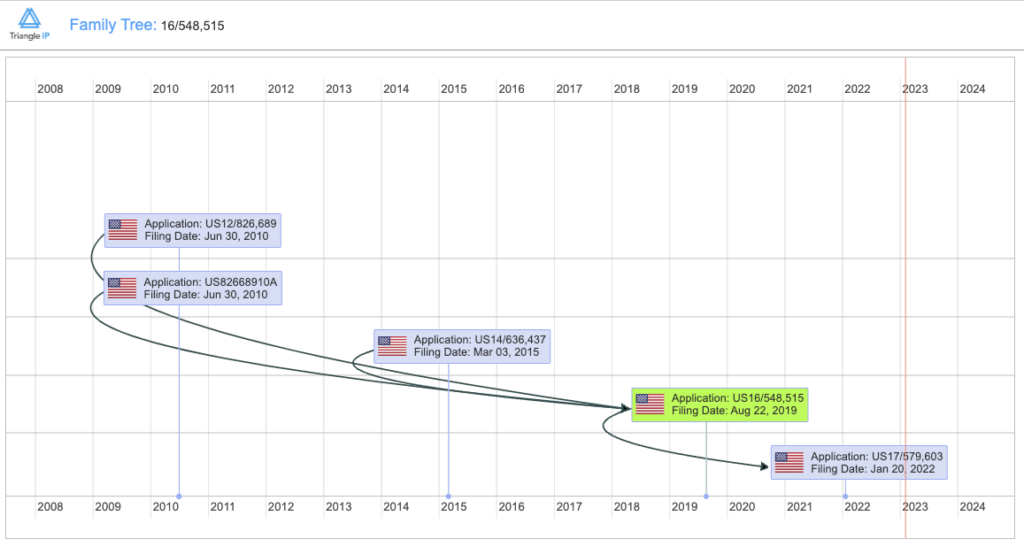
US16/548,515 Patent Family Tree, Generated using The TIP Tool
The TIP Tool can also display a patent family tree on a Gantt chart. Each application in the family tree is displayed as a bar. The length of the bar tells you the filing date, pendency, and expiration date. Importantly, this visualization can instantly tell you the amount of time that the applications overlap.
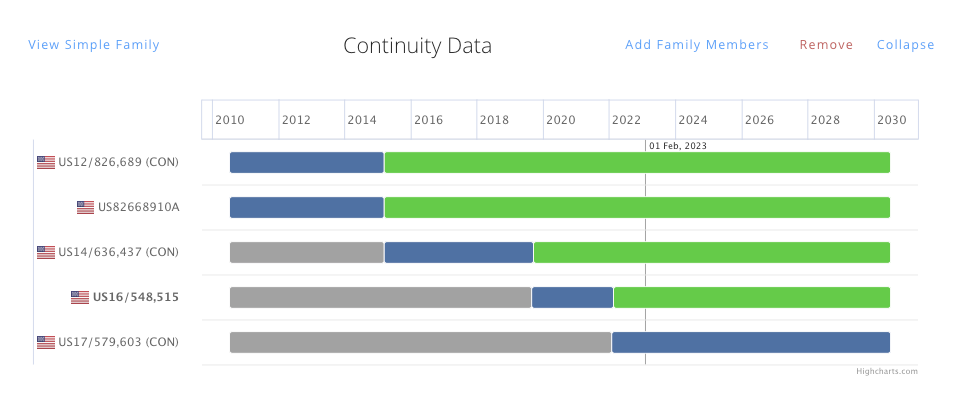
US16/548,515 Patent Family Tree (Gantt Chart Style), Generated using The TIP Tool
The bars include printed information to show which application is your application of interest and the types of documents with a family relationship to it. Different document types have different printed legends like PRO for provisional applications and CON for continuation applications.
Deep links connect the boxes in the visualization to detailed information about each patent application or patent. The Gantt chart is interactive and updates as you modify the application of interest in the family tree.
As a result, you get a clean display free of clutter. The Gantt chart only displays the patents and patent applications with direct priority claims and eliminates from the view grandparent or sibling relationships.
Also read: How to Effortlessly Use the TIP Tool’s Free Patent Family Tree Generator.
Using Patent Family Tree Generators in Your Business
Patent families are important tools for creating a web of interconnected patents and patent applications. They are particularly useful in strategies for patent monetization due to their interconnected nature. Using free tools like the TIP Tool and others can give you an instant understanding about your patent portfolio and those of your competitors. The visualizations you generate will assist you to better manage and plan your patents and applications. It can also help you analyze the patent portfolios of other companies in your business to identify commercial opportunities.
To learn more about the TIP Tool and its patent family tree generator, access the free demo playground.

